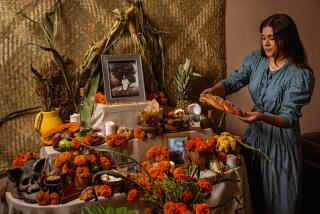THE AFTERLIFE OF THE PARTY : Fullerton’s Day of the Dead Exhibit Embraces a Mexican Tradition With a Skeleton Crew
- Share via
Make no bones about it, the dancing skeletons, grinning skulls, and whimsically macabre afterlife-size mariachi band at Fullerton Museum Center are meant to delight, not frighten.
“It’s coming, so you might as well have a good time,” said museum center curator Lynn La Bate, echoing the attitude about death underlying El Dia de los Muertos, the Mexican tradition examined in the center’s exuberant 100-piece display. “Day of the Dead: A Consequence of Life” opening Friday.
A fusion of Pre-Columbian Mexican Indian and Catholic concepts, the holiday is based on the idea that death is an integral and inevitable part of life to be embraced, not feared. It is a time for remembering the dead and rejoicing life.
“The Day of the Dead is not like Halloween,” although the holidays coincide, La Bate said recently. “It revolves around a very different notion that you expect death, you joke and laugh with death, you make a friend of it.”
Skeletons emblematic of Day of the Dead populate the exhibit, appearing as human-scale, papier-mache hombres strumming guitars or tiny figures made of wood or clay placed in politically satirical tableaux. One, titled “Our American Friends,” features a seated man and woman seemingly cradling bottles of booze and eternally transfixed in front of a television set.
The depiction of skeletal forms in Mexican imagery is centuries old. But early 20th-Century Mexican printmaker Jose Guadalupe Posada helped popularize their use in modern times with calaveras, newspaper illustrations and prose that expressed his social, historical and political observations, La Bate said. Several Posada calaveras are on view, including portrayals of the downtrodden worker and the folk hero Don Quixote and his horse, all drawn without a bit of meat on their skinny bones.
The exhibit’s centerpiece is the life-size, skeletal mariachi band made of papier-mache by the Linares family, three generations of internationally known artists from Mexico City who have often turned to Posada for inspiration. Other Linares works, such as a brilliantly colored, flying lizard-like creature with skull head, Monarch butterfly wings and lethal-looking talons, incorporate an engaging element of the fantastic or alebrije, La Bate said.
Day of the Dead celebrators construct altars or ofrendas (offerings) for the deceased, lovingly adorned with candles, fresh marigolds, sugar skulls that children eat to internalize an acceptance of death, and favorite foods of the departed, believed to return briefly during the holiday. Herminia Albarran, an expert folk artist from Southern Mexico, has created a large ofrenda for the show, decorating it with delectable pan de muerto (bread of the dead) and delicate papel picado (cut paper) streamers.
“At midnight the spirits come,” Albarran said of rituals she has attended. “The family doesn’t sleep because they believe the spirits are with them. They watch the candles and pray. At the time of sunrise, the departed souls return and you have to say goodby.”
Pre-Columbian artifacts, contemporary photographs and other works also make up the exhibit, which La Bate hopes will bring about a greater awareness of Day of the Dead.
“There was no major celebration of the holiday in North County or Orange County as a whole, so we thought this was a good opportunity to showcase a Mexican tradition that was forgotten or not well known,” she said.
Other events to be held at the museum in conjunction with the exhibit are:
* Nov. 16--a family workshop on mask-making from 1 to 3 p.m. and music by Queztalcoatl, a Mexican folk trio, at 7:30 and 9:30 p.m.
* Nov. 23--A children’s science workshop on the human body in which participants will make paper skeletons. Two sessions, noon to 2 p.m. and 2:30-4:30 p.m.
* Dec. 5 through 8, during gallery hours--Demonstrations in the art of papier-mache.
Reservations for the first two workshops must be made by the preceding Wednesday. For the free papier-mache demonstration, spectators may come and go during gallery hours.
Admission to all events but the demonstration is $10.
What: “The Day of the Dead: A Consequence of Life.”
When: Friday, Nov. 1, through Jan. 5. Hours: 11 a.m. to 4 p.m., Tuesday, Wednesday, Saturday and Sunday; 11 a.m. to 9 p.m., Thursday and Friday.
Where: Fullerton Museum Center, 301 N. Pomona Ave., Fullerton.
Whereabouts: Take the Orange (57) Freeway to Chapman Avenue exit. Drive west to Pomona Avenue (one block past Lemon Street) and turn left.
Wherewithal: Admission is free.
Where to call: (714) 738-6545.
More to Read
Sign up for Essential California
The most important California stories and recommendations in your inbox every morning.
You may occasionally receive promotional content from the Los Angeles Times.










